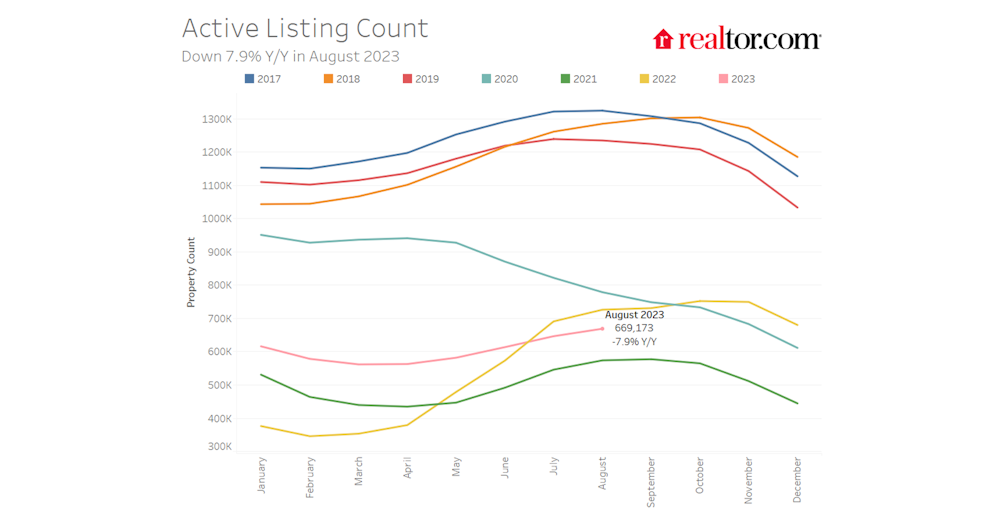Challenges to Homeownership

The housing market operates within a dynamic ecosystem influenced by various factors, and one of the most significant is mortgage rates. In recent years, we've seen substantial shifts in the global economy and financial landscape, impacting mortgage rates. Let’s explore how current mortgage rates are reshaping the housing market, focusing on their effects on housing prices, inventory, and homebuilders.
Mortgage rates and housing prices are out of sync
In an unusual twist, the current mortgage rates are exhibiting an intriguing departure from the typical script in the housing market. Traditionally, when the Federal Reserve raises interest rates, it tends to trigger a decline in housing prices. However, the landscape today tells a different story. According to the Case-Shiller Home Price Index, the average home price has only dipped by a modest 1.2% from its peak in June 2022. “Even as the Fed tries to slow down housing demand to temper inflation, the result of today’s limited supply of available housing is that we may not see a significant deterioration in home values,” said Matt Schoeppner, Senior Economist at U.S. Bank. Additionally, the low mortgage rates from 2019 through 2022 have locked existing homeowners into their homes, further driving up the prices for an already limited supply of existing inventory.1

The aggressive interest rate increases have led to much more expensive mortgages and priced some buyers out of the market as now home sale prices are up 4.5% from this time last year. “Mortgage applications declined to the lowest level since December 1996, despite a drop in mortgage rates. Both purchase and refinance applications fell, with the purchase index hitting a 28-year low, as prospective buyers remain on the sidelines due to low housing inventory and elevated mortgage rates,” said Joel Kan, Mortgage Bankers Association's (MBA) Vice President and Deputy Chief Economist.2
What emerges from this atypical scenario is a housing market where mortgage rates and housing prices appear to be out of sync. Even as rates continue to rise, the value (price) of homes remains remarkably stable. At the end of the day, regardless of mortgage rates, we believe there is a supply and demand imbalance that is the real driving force behind housing dynamics.
Mortgage Rates and Housing Inventory
According to Realtor, there were 47.8% fewer active home listings in August 2023 compared to average levels seen in 2017 to 2019 and the lowest level since 1999. This unprecedented drop in listings has led to increased competition for available homes, further driving up the prices. When the Fed stops raising interest rates and inflation subsides, buyers may re-enter the market, but the lack of inventory will remain.
We see the housing housing deficit is an issue that will persist as interest rates and inflation rates rise and fall. Even as buyers potentially regain their confidence and activity, the fundamental dilemma of limited housing options will continue to shape the housing market's dynamics. Sam Khater, Freddie Mac’s Chief Economist, shared his outlook for the housing market: “As rates remain high and supply of unsold homes woefully low, incoming data shows that existing homes sales continue to fall. However, there are slightly more new homes available, and sales of these new homes continue to rise, helping provide modest relief to the unyielding housing inventory predicament.”3

Mortgage Rates and Homebuilders
In the current market of rising home prices and interest rates, homebuilders have emerged with confidence going forward as the demand for new homes grows. CEO of KB Home, Jeff Mezger, Fortune in an interview that “[T]here is a shortage of new homes and resale homes that are fueling a lack of inventory; at the same time, we have strong demographic demand from the millennials and Gen Z’s now hitting homebuying years. So when you have strong [demographic] demand, and no inventory, and even though rates have moved up, demand is still strong enough that buyers adjust to the [mortgage] rates and sales remain robust."4
And the data supports this. The U.S. Census Bureau and the Department of Housing and Urban Development reported in an August press release that new home sales have increased 31.5% from July of 2022. Homebuilders are mindful of the rising home prices, and many are designing smaller homes, which could entice first time homebuyers. The National Association of Home Builders reports that the average size of a new house has decreased from about 2,530 square feet in 2021 to 2,200 square feet in 2023. There has also been more interest in condos or townhomes rather than the traditional single-family detached home, "not only because of maintenance issues but also because of the price and affordability. And now that they're appreciating at the same rate or even better than single-family homes, that makes it more attractive,” said Steve Jolly, who led Great Nashville Realtors in 2022.5
We believe today's homebuyers are eager to buy and this boost in demand can lead to a surge on new housing developments, creating jobs, and stimulating economic growth in the construction sector. As we look at the market going forward, it is clear that building more houses and closing the inventory deficit is the only way to return to a healthy housing market. It is an encouraging sign that builders are confident as buyer demand remains strong.
 © Copyright 2024, The True Life Companies. All Rights Reserved. Website Design by Kovach Marketing. Development & Hosting by Blue Tangerine.
© Copyright 2024, The True Life Companies. All Rights Reserved. Website Design by Kovach Marketing. Development & Hosting by Blue Tangerine.